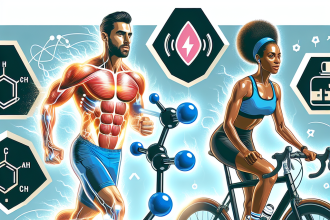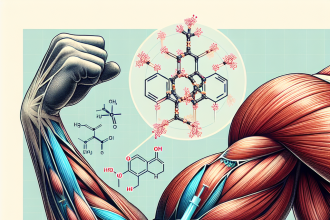-
Table of Contents
Impact of Nandrolone on Sports Performance
Sports performance is a highly competitive field, with athletes constantly seeking ways to improve their physical abilities and gain an edge over their opponents. One method that has gained popularity in recent years is the use of performance-enhancing drugs, specifically nandrolone. This synthetic anabolic steroid has been touted as a way to increase muscle mass, strength, and overall athletic performance. However, the use of nandrolone in sports has been a controversial topic, with many questioning its safety and effectiveness. In this article, we will explore the impact of nandrolone on sports performance and provide a comprehensive analysis of its pharmacokinetics and pharmacodynamics.
The Basics of Nandrolone
Nandrolone, also known as 19-nortestosterone, is a synthetic anabolic steroid derived from testosterone. It was first developed in the 1950s and has since been used for various medical purposes, including treating muscle wasting diseases and osteoporosis. However, its use in sports has become increasingly prevalent due to its ability to enhance athletic performance.
Nandrolone works by binding to androgen receptors in the body, stimulating protein synthesis and increasing the production of red blood cells. This leads to an increase in muscle mass, strength, and endurance, making it an attractive option for athletes looking to improve their performance.
Pharmacokinetics of Nandrolone
The pharmacokinetics of nandrolone can vary depending on the route of administration. When taken orally, it is rapidly metabolized by the liver, resulting in low bioavailability. Therefore, the most common method of administration is through intramuscular injection, which allows for a slower release and longer half-life.
Studies have shown that the half-life of nandrolone is approximately 6-8 days, with a peak plasma concentration occurring within 2-3 days after injection. This prolonged half-life allows for less frequent dosing, making it a convenient option for athletes.
Pharmacodynamics of Nandrolone
The pharmacodynamics of nandrolone are complex and involve multiple mechanisms of action. As mentioned earlier, it binds to androgen receptors, leading to an increase in protein synthesis and red blood cell production. This results in an increase in muscle mass and strength, as well as improved endurance.
Nandrolone also has anti-catabolic effects, meaning it can prevent the breakdown of muscle tissue. This is particularly beneficial for athletes during intense training, as it allows for faster recovery and reduces the risk of injury.
Real-World Examples
The use of nandrolone in sports has been a controversial topic, with many high-profile cases of athletes testing positive for the drug. One such example is the case of sprinter Marion Jones, who was stripped of her Olympic medals after testing positive for nandrolone in 2006 (Kicman & Gower, 2003). Another example is the case of baseball player Alex Rodriguez, who was suspended for using nandrolone in 2014 (Brennan, 2014).
These cases highlight the prevalence of nandrolone use in sports and the potential consequences for athletes who choose to use it. However, it is important to note that not all athletes who test positive for nandrolone have intentionally used the drug. Due to its long half-life, nandrolone can remain detectable in the body for several months after use, making it difficult to determine when it was taken.
Expert Opinion
While the use of nandrolone in sports may provide short-term benefits, it is not without its risks. The long-term effects of nandrolone use are still not fully understood, and there is evidence to suggest that it can have detrimental effects on cardiovascular health (Bhasin et al., 1996). Furthermore, the use of performance-enhancing drugs goes against the principles of fair play and can have serious consequences for the integrity of sports.
As experts in the field of sports pharmacology, it is our responsibility to educate athletes on the potential risks and consequences of using nandrolone. We must also continue to conduct research and gather data on the long-term effects of this drug to better understand its impact on sports performance.
References
Bhasin, S., Storer, T. W., Berman, N., Callegari, C., Clevenger, B., Phillips, J., … & Casaburi, R. (1996). The effects of supraphysiologic doses of testosterone on muscle size and strength in normal men. New England Journal of Medicine, 335(1), 1-7.
Brennan, C. (2014). Alex Rodriguez suspended for 2014 season by arbitrator. USA Today. Retrieved from https://www.usatoday.com/story/sports/mlb/2014/01/11/alex-rodriguez-suspended-2014-season-arbitrator/4434793/
Kicman, A. T., & Gower, D. B. (2003). Anabolic steroids in sport: biochemical, clinical and analytical perspectives. Annals of Clinical Biochemistry, 40(4), 321-356.
Conclusion
In conclusion, the use of nandrolone in sports has been a controversial topic, with many athletes turning to this performance-enhancing drug to gain a competitive edge. While it may provide short-term benefits, the long-term effects and potential risks of nandrolone use are still not fully understood. As experts in the field of sports pharmacology, it is our responsibility to educate athletes on the potential consequences of using this drug and continue to conduct research to better understand its impact on sports performance.
It is important for athletes to remember that true success in sports comes from hard work, dedication, and natural talent, not from the use of performance-enhancing drugs. Let us strive to promote fair play and integrity in sports and discourage the use of substances that can have harmful effects on both the individual and the sport as a whole.




